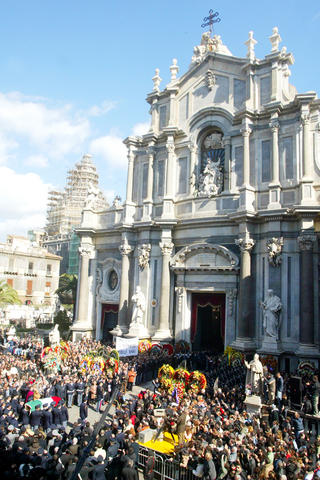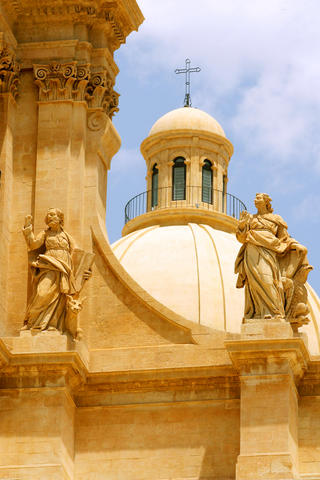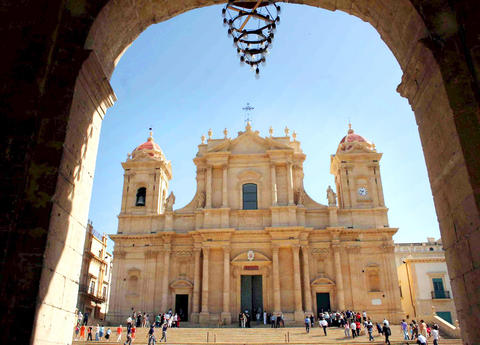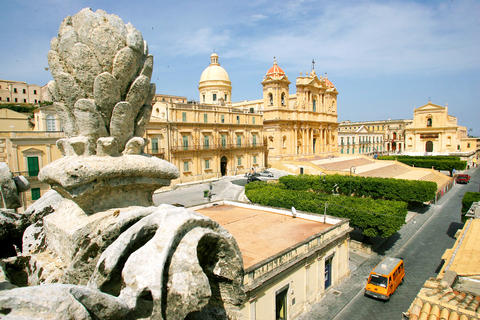The day before we left for Sicily, there was an earthquake in south-east England. It measured 4.3 on the Richter scale, which, according to the US Geological Survey, can lead to "a noticeable shaking of indoor items and rattling noises." A local woman was admitted to hospital with neck pains.
The consequences were slightly more serious on January 11, 1693, when an earthquake flattened the town of Noto in southern Sicily. But out of the cataclysm that struck that day emerged a thing of extraordinary beauty. Within a week, an aristocratic architect, the Duke of Camastra, had been commissioned to rebuild the place and went on to produce one of the most beautiful baroque towns in the world.
It took nearly two hours to drive from Catania airport to our hotel just outside Noto - almost as long as it took to get out of the airport itself. It is not recorded which day of the week the Greeks, Romans, Phoenicians, Carthaginians, Arabs, Normans and the rest chose to invade Sicily, but it probably wasn't Sunday. By the time the baggage handlers had unloaded their kit, the element of surprise would have been lost.

PHOTOS: AFP AND AP
The journey south is not one that prepares you well for your destination. After a couple of dozen kilometers of Catania's ugly suburbs and Syracusa's zona industriale, we started to feel slightly uneasy. I hadn't put Sicily and industrialization together. Which is daft when you consider that Palermo is the fifth biggest city in Italy, and Catania the ninth. Big cities need concrete, and workers need factories. They also need cars. Which are driven by mad people. I had driven on the island before, so I knew what to expect: utter, unmitigated terror.
The article I had photocopied that was headlined "50 foodie things to do before you die" began to take on a rather literal meaning as I found myself stranded on a roundabout outside Catania, in the automobile equivalent of the Mexican standoff scene at the end of Reservoir Dogs.
Beyond Siracusa the traffic thinned, my heart rate slowed, and suddenly the countryside was all flowers and hills and we were in a different Sicily. The Antica Masseria Corte del Sole calls itself a hotel, but it's really a very posh agriturismo. It's a couple of kilometers outside Noto at the end of a dirt track, the turning to which is easy to miss (we missed it twice), and is surrounded by fields and orchards. The building is a meticulously restored 19th- century farmhouse - white stone walls, terracotta roof, tiled floors - with 24 rooms on two floors surrounding a central courtyard that would make a perfect setting for a shoot-out in a spaghetti western. An old mill and olive-pressing room has been turned into a bar, and the restaurant is a converted outhouse.

Our room was on the first floor, reached by an outside stone staircase lined with flowering jasmine in pots and bright red perlagoniums in window boxes. And, as we discovered the next morning, an extraordinary view across a nature reserve: the Vendicari, an 8km-long expanse of wild fields, lagoons and marshland stretching to the sea, dotted all the way with wild flowers. The wilderness beckoned, but we decided to head for Noto. It would be silly not to.
We entered the town from the east through the public garden, where the air was sweet, this time from rows of blossoming pittosporum. Then it was through the Porta Reale, built in 1838 as a sign of the town's allegiance to the Bourbons, and on to Corso Vittorio Emmanuele, named to formalize its new-found loyalty to the House of Savoy after the Bourbons left in a hurry a couple of decades later. The Sicilian writer Leonardo Sciascia called Noto a "garden of stone, a city of gold, a theatrical city," and the drama begins with Vincenzo Sinatra's (creativity clearly ran in the family) church of San Francisco at the east end of Corso Vittorio Emmanuele and unfolds with a stunning sequence of ochre and honey-colored churches and palazzos that sway and swerve, concave then convex, light then shade, all the way to Rosario Gagliardi's Chiesa di San Domenico in the west. It may be the most thrilling street in Sicily. Along the way, the duomo, at the top of a grand staircase, is still closed, as it has been since the cupola collapsed in a thunderstorm in 1996, but the scaffolding is slowly (very slowly) coming down, and it's still a breath-stealing sight.
But the real show takes place just round the corner in Via C Nicolaci at - ta-dah! - the Palazzo Villadorata, a piece of baroque high-camp featuring six lavish balconies supported by buttresses bearing a bizarre collection of sculpted nymphs, griffins, horses, and very scary bald men.

We had ice cream at the Corrado Costanzo in via Spaventa off the main square. Some people say Costanzo's serves the best ice creams in the world, but the granitas round the corner at Caffe Sicilia are pretty amazing too, even if it's been a few years since they made them with snow brought down from the caves around Mount Etna. Maybe Noto has the two best ice cream parlors in the world.
The next day, it was already hot as we set off for Vendicari, a five-minute drive from the masseria towards the southernmost tip of Sicily. We were too late in the year for the migrating herons, swans, flamingos, cormorants and others that rest here, but, in the absence of birds and birdwatchers, we had the place almost to ourselves. This time, the scent was of wild thyme and rosemary, prickly juniper and broom as we walked towards the ancient ruins of Eloro via the magnificent unspoilt sandy bay at Calamosche. The beach didn't seem Italian: no military rows of sun loungers, no super-tanned bagnini telling you to shove up so they can squeeze in another parasol, definitely no posing, and no entry charge.
Lunch turned out to be one of those holiday moments that only happen to other people. We saw a sign for an agriturismo, it was deserted so we asked if they were open, they said yes, we got a table, hordes of other people turned up, then we ate one of the best meals of our lives. The place was called the Torre Vendicari where, as the waitress explained, apologetically, on public holidays they only serve the fish tasting menu. Shame. This is what we ate: grilled mussels coated in orange zest and breadcrumbs; octopus salad with mint, olives, carrots and potatoes; a sea bream frittata; pappardelle with swordfish; risotto al mare; a plate of grilled swordfish, prawns and calamari; octopus in red wine. And a bottle of red wine made with grapes grown round the corner. It cost US$30 each.

The next day, we set off for Castel di Tusa, and as we drove north back towards Catania we saw the thing we had missed on the way down: Etna. There it is in front of you - huge, dark and fuming - and it stays there until you take a sharp left on to the A19 and head inland for Enna. It's an exhilarating drive along hundreds of kilometers of elevated autostrada. Most guide books have little to say about the Sicilian interior - "barren" is about as positive as it gets - but if you go outside the scorching summer months it is a stunning expanse of green and yellow hills and fields.
Driving directly north, Etna fades away and the giant Madonie mountains appear like a chain of granite bouncers protecting the Tyrrhenian coast. Castel di Tusa is a seaside resort with a difference. Right on the sweeping, elegant bay, next to the pebble beach, is L'Atelier sul Mare, a "hotel-museum" of contemporary art owned by Antonio Presti. It's a hotel because there are 40 bedrooms, and it's a museum because 15 of the rooms (they are currently installing three more) are unique art spaces designed by artists from around the world.
The first night we stayed in Il Nido (The Nest), a round, enclosed bed complete with "feather"-covered duvet. Then we were packing our bags and moving down the corridor to the Energia, where the red lighting shimmers to the sound of the waves on the beach. Even the showers are art statements. There's a waterfall in one room, and in another a walk-in car wash (Presti's own homage to film maker Pier Paolo Pasolini, who was killed by a car).
Presti is a one-man art movement. As well as his hotel, he presides over a sculpture park that stretches from the sea up into the mountains. The local council hate him, and the mafia bombed his hotel, but he won't stop.
In between sleeping with art, we spent a day in Cefalu, a town that is impossible to dislike. A long, sandy beach curves for a couple of miles away from a medieval town built under an enormous rock outcrop. There's a dramatic Norman cathedral (built by Roger I in 1131. Nice one, Roger) with a palm-fringed piazza, a labyrinth of steep Arab/Norman alleys, a Saracen wash-house, stupendous views along the coast, and the Trappitu restaurant, where you eat oysters the size of cricket balls and clams the size of oysters on a terrace overlooking the sea.
All that was left was the drive to Palermo airport.

On April 26, The Lancet published a letter from two doctors at Taichung-based China Medical University Hospital (CMUH) warning that “Taiwan’s Health Care System is on the Brink of Collapse.” The authors said that “Years of policy inaction and mismanagement of resources have led to the National Health Insurance system operating under unsustainable conditions.” The pushback was immediate. Errors in the paper were quickly identified and publicized, to discredit the authors (the hospital apologized). CNA reported that CMUH said the letter described Taiwan in 2021 as having 62 nurses per 10,000 people, when the correct number was 78 nurses per 10,000

As Donald Trump’s executive order in March led to the shuttering of Voice of America (VOA) — the global broadcaster whose roots date back to the fight against Nazi propaganda — he quickly attracted support from figures not used to aligning themselves with any US administration. Trump had ordered the US Agency for Global Media, the federal agency that funds VOA and other groups promoting independent journalism overseas, to be “eliminated to the maximum extent consistent with applicable law.” The decision suddenly halted programming in 49 languages to more than 425 million people. In Moscow, Margarita Simonyan, the hardline editor-in-chief of the

Six weeks before I embarked on a research mission in Kyoto, I was sitting alone at a bar counter in Melbourne. Next to me, a woman was bragging loudly to a friend: She, too, was heading to Kyoto, I quickly discerned. Except her trip was in four months. And she’d just pulled an all-nighter booking restaurant reservations. As I snooped on the conversation, I broke out in a sweat, panicking because I’d yet to secure a single table. Then I remembered: Eating well in Japan is absolutely not something to lose sleep over. It’s true that the best-known institutions book up faster

Though the total area of Penghu isn’t that large, exploring all of it — including its numerous outlying islands — could easily take a couple of weeks. The most remote township accessible by road from Magong City (馬公市) is Siyu (西嶼鄉), and this place alone deserves at least two days to fully appreciate. Whether it’s beaches, architecture, museums, snacks, sunrises or sunsets that attract you, Siyu has something for everyone. Though only 5km from Magong by sea, no ferry service currently exists and it must be reached by a long circuitous route around the main island of Penghu, with the